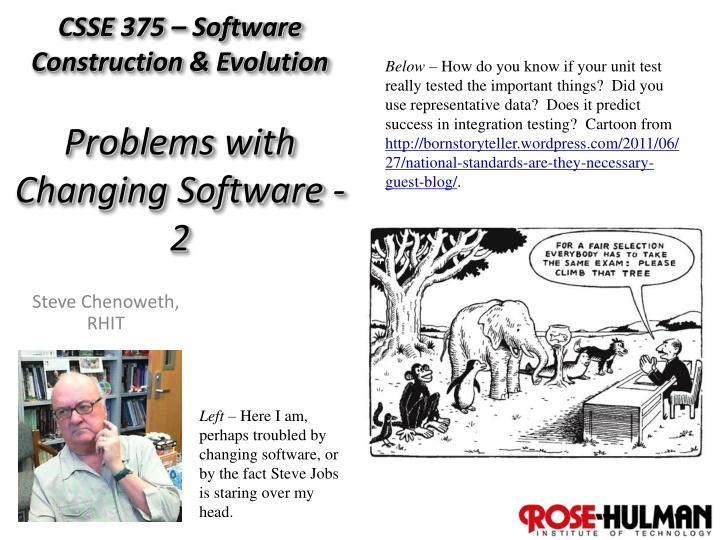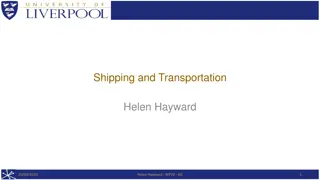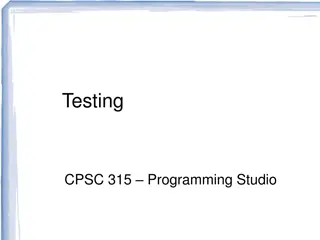Ensuring Effective Unit Testing and Predicting Integration Testing Success
Unit testing is crucial in software development, but how do you know if it truly tests the important aspects? Using representative data and considering success in integration testing can provide insights. Challenges like hidden dependencies and irritating global dependencies may impact the effectiveness of unit testing. Addressing these issues, such as avoiding singletons during testing, can enhance the testing process.
Download Presentation

Please find below an Image/Link to download the presentation.
The content on the website is provided AS IS for your information and personal use only. It may not be sold, licensed, or shared on other websites without obtaining consent from the author.If you encounter any issues during the download, it is possible that the publisher has removed the file from their server.
You are allowed to download the files provided on this website for personal or commercial use, subject to the condition that they are used lawfully. All files are the property of their respective owners.
The content on the website is provided AS IS for your information and personal use only. It may not be sold, licensed, or shared on other websites without obtaining consent from the author.
E N D
Presentation Transcript
CSSE 375 Software Construction & Evolution Below How do you know if your unit test really tested the important things? Did you use representative data? Does it predict success in integration testing? Cartoon from http://bornstoryteller.wordpress.com/2011/06/ 27/national-standards-are-they-necessary- guest-blog/. Problems with Changing Software - 2 Steve Chenoweth, RHIT Left Here I am, perhaps troubled by changing software, or by the fact Steve Jobs is staring over my head. 1
Ch 9 Ch 9 Test harness problems* Irritating parameter Hidden dependency Construction blob Irritating global dependency Horrible include dependencies Onion parameter Aliased parameter Let s look at this one * Note that you don t have to use test-first for these to be useful! They all are practical in promoting unit testing or earlier integration testing, as well. 2
Ch 9 Irritating global dependency We have a system that records building permits for a governmental agency. One Java class is this: We d like to test instances of this class What s to stop us? Q1 3
Ch 9 Irritating global dependency, cntd The dependency rears its head This is a singleton, a global value 4
Ch 9 Irritating global dependency, cntd Getting rid of it, for testing We only use this during testing! For production, it remains a singleton. Q2 5
Ch 9 Irritating global dependency, cntd How it s used in testing 6
Ch 9 Notice the emphasis on ease of testing Feathers believes ease of unit testing is almost the same as the question of reuse Classes that are not easy to test, because of test- first problems like the list on slide 2, also are not easy to extend with children. Q3 7
Ch 10 A few more cool examples Ch 10 I can t run this method in a test harness. Reasons could include: Method not accessible to the test Hard to construct the parameters to call a method Method has bad side effects, like modifying a database or launching a cruise missile Need to sense through some object that the method uses Feathers investigates these problems, one at a time. 8
Ch 10 Testing a private method Feathers opening comments: Private methods tend to be of dubious quality. They often look very general, but really work only for the things in their class that use them. Making them public opens a can of worms! 9
Ch 10 Private methods, cntd Thus, these represent things that are inherently not testable questionable design. His example (in C++): class CCAImage { private: public: }; void setSnapRegion(int x, int y, ind dx, int dy); void snap(); Q4 10
Ch 10 Private methods, cntd Feathers solution: Make the private class protected instead of private. Then delegate to a testing subclass: class TestingCCAImage : public CCAImage { public: void setSnapRegion(int x, int y, ind dx, int dy) { // call the setSnapRegion of the superclass CCAImage::setSnapRegion(x, y, dx, dy) } }; 11
Ch 10 Undetectable side effects Feathers example a class that calls methods on other objects, and we never have a clue how things turn out: Public class AccountDetailFrame extends Frame implements ActionListener, WindowListener { private TextField display = new TextField(10); public AccountDetailFrame( ) { } } public void actionPerformed(ActionEvent event) { String source = (String)event.getActionCommand(); if (source.equals( project activity )){ DetailFrame detailDisplay = new DetailFrame(); detailDisplay.setDescription( detailDisplay.show(); String accountDescription = detailDisplay.getAccountSymbol(); accountDescription += : ; display.setText(accountDescription); } } getDetailText() + + getProjectionText()); Q5 12
Ch 10 Undetectable side effects, cntd Feathers solution separate dependencies, including using Bertrand Meyer s Command / Query separation principle Part 1: Public class AccountDetailFrame extends Frame implements ActionListener, WindowListener { private TextField display = new TextField(10); private DetailFrame detailDisplay; public AccountDetailFrame( ) { } Bertrand Meyer Also author of the Eiffel programming language and of design by contract programming. public void actionPerformed(ActionEvent event) { String source = (String)event.getActionCommand(); performCommand(source); } public void performCommand(String source){ if (source.equals( project activity)){ setDescription(getDetailText() + + getProjectionText()); String accountDescription = detailDisplay.getAccountSymbol(); accountDescription += : ; setDisplayText(accountDescription); } } Q6 cntd 13
Ch 10 Undetectable side effects, cntd Feathers solution separate dependencies, including using Bertrand Meyer s Command / Query separation principle Part 2: } void setDescription(String description){ detailDisplay = new DetailFrame(); detailDisplay.setDescription(description); detailDisplay.show(); } String getAccountSymbol(){ return detailDisplay.getAccountSymbol(); } void setDisplayText(String description){ display.setText(accountDescription); } } 14
Ch 10 Undetectable side effects, cntd We can now subclass and override to test whatever code is left in performCommand: public class TestingAccountDetailFrame extends AccountDetailFrame { String displayText = ; String accountSymbol = ; void setDescription(String description{ } String getAccountSymbol(){ return accountSymbol; } void setDisplayText (String text){ displayText = text; } } 15
Ch 10 Undetectable side effects, cntd And a test exercise on the performCommand method would look like this: public void testPerformCommand(){ TestingAccountDetailFrame frame = new TestingAccountDetailFrame(); frame.accountSymbol = SYM ; frame.performCommand( project activity ); assertEquals( SYM: basic account , frame.displayText); } Q7 16
Ch 11 Another cool example Ch 11 Impact analysis during maintenance Feathers dream tool he highlights code in the IDE, and it tells him everything impacted if he changes that code! Need to reason backward and forward about changes Backward = deduce the set of objects that affect values at a particular point in code. Forward = look at a set of objects and determine what will change downstream if they stop working. Q8 17
Ch 11 Reasoning forward example This is what generates index now! We want to make changes to this code, to allow the index to change as items are added to the ArrayList: public Element generateIndex() { Element index = new Element("index"); for(Iterator it = elements.iterator(); it.hasNext();){ Element current = (Element)it.next(); index.addText(current.getName()+"\n"); } addElement(index); return index; } public Element getElement(String name){ for (Iterator it = elements.iterator(); it.hasNext();){ Element current = (Element)it.next(); if (current.getName().equals(name)) { return current; } } return null; } import java.util.ArrayList; import java.util.Iterator; /** * @author chenowet. * Created Jul 12, 2011. */ public class InMemoryDirectory { private ArrayList<Element> elements = new ArrayList(); public void addElement(Element newElement){ elements.add(newElement); } public int getElementCount(){ return elements.size(); } } 18
Ch 11 Reasoning forward example, cntd Issues: Need to generate the index last -- it doesn t work if rebuilt. But this was ok in the existing app. Now, we d like index creation and maintenance to happen automatically as a side effect of adding elements. How to test as we develop this change? 19
Ch 11 Reasoning forward example, cntd So we need tests that: Add elements in various ways, Generate an index, Get the various elements and see if they are correct, and Test to see if the index is correct. How do we know this is the extent of the testing needed? Q9 20
Ch 11 Reasoning forward example, cntd The tests are just a description of how we expect to use the directory (and revisions to the add function). We know what the directory is supposed to do. But, could we have known this just by looking at the code itself? 21
Ch 11 Reasoning forward example, cntd Our goal is to remove functionality from generateIndex and add it to addElement. So, What calls generateIndex? Nothing in the class itself. So it must just be client classes. What do we modify in generateIndex? We create a new element (the index) and add it to the ArrayList (the directory). Thus, this method affects the elements in the list. But we re not done! 22
Ch 11 Reasoning forward example, cntd Where else is the elements collection used? Used in getElementCount and in getElement. Used in addElement, but we don t care! 23
Ch 11 Reasoning forward example, cntd Also need to look at how addElement impacts the surrounding software: It affects the elements collection. But we re not done! 24
Ch 11 Reasoning forward example, cntd As before, we also need to see what the elements collection itself can affect, giving this overall picture: 25
Ch 11 Reasoning forward example, cntd Could we have missed anything? Superclasses and subclasses? Is the data in InMemoryDirectory public? Not in this case! What about the elements themselves? Q10 26
Ch 11 Reasoning forward example, cntd /** * @author chenowet. * Created Jul 12, 2011. */ public class Element { public String getName(){ return this.name; } public void addText(String newText){ this.text = this.text + newText; } public String getText(){ return this.text; } } private String name; private String text; public Element(String name){ this.name = name; this.text = ""; } 27
Ch 11 Reasoning forward example, cntd So, overall, the impacts are: 28
Ch 11 Reasoning forward example, cntd Heuristics for analyzing effects propagation: Look for methods returning values Assuming these are used! An object that takes another object as a parameter Can change that object! Depends on the language Other side effects like Changing global or static data Q11 29























